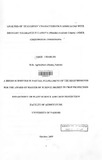| dc.description.abstract | Cassava (Manihot esculenta Crantz) ranks as the fourth most important staple food cultivated and consumed mainly in the tropics and other developing countries. The crop yields well in areas with uncertain rainfall patterns and prolonged drought. Leaf retention or longevity (staygreen) has been associated with sustained cassava production under drought. This study analyzed and screened for this characteristic in both transgenic and non transgenic cassava genotypes under greenhouse conditions.
Significant (P:S0.05) genotypic variations in internode growth, leaf abscission, photosynthetic rates, and stomatal conductance under drought stress treatments were observed between transgenic and non-transgenic cassava genotypes. Based on these results, provisional levels of staygreen or drought stress tolerance were assigned to the genotypes. Non-transgenic genotypes 98-0002, 98-2226 and transgenic line 529-48 showed high levels of staygreen, non transgenic genotypes 91-02322, TME-3 and transgenic line 529-28 expressed moderate levels of stay green and non transgenic genotype 95-0306 and wild type TMS 60444 showed drought stress susceptibility.
Expression of staygreen trait was clearly marked out under 30 and 60% levels of drought stress as well as in fully irrigated or control treatment. Photosynthetic rates positively correlated with stomatal conductance and negatively correlated with leaf abscission. Leaf abscission and stomatal conductance correlated negatively.The initial stages of characterization of cassava transcriptome upon drought treatment, (for the identification of up- and down regulated genes), involves RNA purification. It is a pre-requisite
that for successful procedure of microarray-based gene expression profiling, the RNA extracted should be of high integrity, quality and quantity. In this study, the following five protocols were tested, optimized and used in the extraction of RNA from the leaves of cassava genotype TMS 604444: modified CTAB based method, RN easy Plant Minikit, Total Nucleic acid and DNase treatment, protocol described by Reilly et al. (2001)
and Trizol Reagent-based method. The modified CTAB method produced RNA of high concentration (more than 1 microgram), high quality (A260:A280and A260:A230ratios more than 2.0) and high integrity (distinct and visible 28S and 18S rRNA bands) from young and old cassava leaves, compared to RNA (from the same leaftissues) generated by the other four methods. | en |

